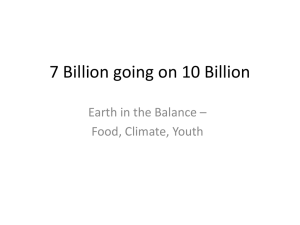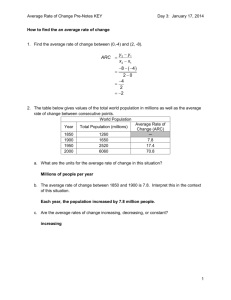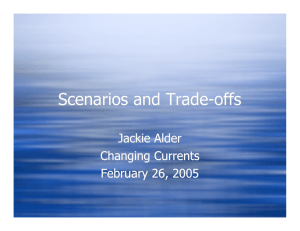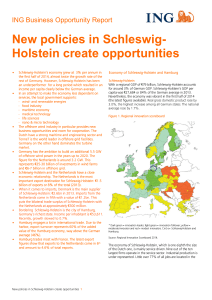CFA 2011 05 24 Nebraska
advertisement
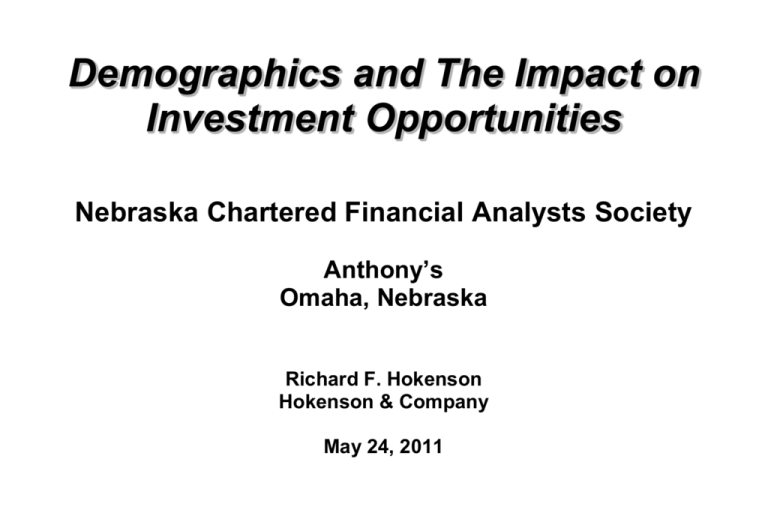
Demographics and The Impact on Investment Opportunities Nebraska Chartered Financial Analysts Society Anthony’s Omaha, Nebraska Richard F. Hokenson Hokenson & Company May 24, 2011 Hokenson & Company is an independent consulting firm specializing in the application of demographics to economic, industry and financial market forecasting. Prior to founding Hokenson & Company in May 2002, Richard Hokenson was the Chief Economist for Donaldson, Lufkin & Jenrette where he pioneered the application of demographics to economic and financial market forecasting. Following the merger with Credit Suisse First Boston in November 2000, he was made the Director of their Global Demographics Project where he continued his responsibility for analysis and forecasting of global demographic trends and their associated economic and investment implications. 1 Agree/Disagree? “Our teeming population is the strongest evidence our numbers are burdensome to the world, which can hardly support us from its natural elements. Our wants grow more and more keen and our complaints more bitter in all mouths, while nature fails in affording us our usual sustenance…” The Speed of Aging: Developed Countries Number of Years for Percent of Population 65+ to rise from 7 to 14 percent 115 France (1865-1980) Sw eden (1890-1975) Australia (1938U.S. (1944-2013) Canada (1944-2009) Hungary (1941-1994) Poland (1966-2013) U.K. (1930-1975) Spain (1947-1992) Japan (1970-1996) 85 73 69 65 53 47 45 45 26 0 20 40 60 80 100 120 140 Speed of Aging: Developing Countries Number of Years for Percent of Population 65+ to rise from 7 to 14 percent 27 27 25 24 23 23 22 21 20 China (2000-2027) Singapore (2001Chile (2000-2025) Jamaica (2009-2033) Sri Lanka (2004-2027) Tunisia (2009-2032) Thailand (2003-2025) Brazil (2011-2032) Colombia (2017-2037) 0 20 40 60 80 100 120 140 Demographics and Destiny Maximum Effective Capital Gains Tax Rate versus Percentage of Young Taxpayers 50 36 45 34 40 Percent 35 32 30 30 25 28 20 26 15 10 24 22 0 20 19 50 19 55 19 60 19 65 19 70 19 75 19 80 19 85 19 90 19 95 20 00 20 05 20 10 20 15 20 20 5 Source: U.S. Treasury; Hokenson & Company Tax Rate % Young Population Trends in The Developed World The Developed World Population Change by Age Groups in Millions: 2005-2015 8 Japan and Europe 9 Japan Population Change by Age Groups in Millions: 2005-2015 10 Japan: Old and Young as Percent of Population 40 35 Percent 30 25 Young Old 20 15 10 5 0 1990 2000 2010 2020 2030 2040 2050 11 Western Europe Population Change by Age Groups in Millions: 2005-2015 12 Aging in the European Union E.U. & Candidates Aged Dependency Ratios (population 65+ as a percent of 15 to 64) 55 50 45 40 35 30 25 20 15 2000 2005 2010 2015 EU 2020 2025 EU + Candidates Sources: US Census Bureau, International Data Base; Hokenson & Company 2030 2035 2040 EU + Candidates ex Turkey 2045 2050 The American “Exception” 14 Total Fertility Rate for Selected Regions and Countries: 2010 2.2 2.0 1.8 1.6 1.4 1.2 1.0 United States Western East Europe Europe Japan Russia China Source: United Nations; Hokenson & Company. 15 Legal Immigration and Naturalizations 2.0 1.8 1.6 Millions 1.4 1.2 1.0 0.8 0.6 0.4 0.2 0.0 1970 1975 1980 1985 1990 1995 2000 2005 2010 Legal Inflows Naturalizations Total Population: US versus Eurozone 440 420 400 Millions 380 360 US Eurozone 340 320 300 280 260 240 1990 2000 2010 2020 2030 2040 2050 17 United States : Number of Entry-Level Workers The United States Population Change by Age Groups in Millions: 2005-2015 19 Annualized Growth in Total and Married Couple Households 1.6 1.4 Percent 1.2 1.0 1980-1990 1990-2000 2000-2007 0.8 0.6 0.4 0.2 0.0 Total Households Married Couple Households Sources: U.S. Census Bureau; Hokenson & Company. Social (In)Security? 21 United States: Population in Millions (2010) 22 United States: Population in Millions (2050) 100+ 95-99 90-94 85-89 80-84 75-79 70-74 65-69 60-64 55-59 50-54 45-49 40-44 35-39 30-34 25-29 20-24 15-19 10-14 5-9 0-4 Male 15 10 5 Sources: United Nations; Hokenson & Company. Female 0 5 10 15 23 The Developing World with a focus on BRIC Brazil Russia India China 2004 2001 1998 1995 1992 1989 1986 1983 1980 1977 1974 1971 1968 1965 1962 1959 Years Russian Federation: Life Expectancy at Birth 75 70 65 Female Male 60 55 Russian Federation: Total Population: 1990-2050 150 145 Millions 140 135 130 125 120 115 110 1990 2000 2010 Sources: United Nations; Hokenson & Company. 2020 2030 2040 2050 Russian Federation : Number of Entry-Level Workers 26 24 Millions 22 20 18 16 14 12 10 1990 2000 2010 Sources: United Nations; Hokenson & Company. 2020 2030 2040 2050 China Population Change by Age Groups in Millions: 2005-2015 60 50 40 30 20 10 0 -10 -20 -30 -40 0-9 10-19 20-29 30-39 40-49 50-59 60-69 70-79 80+ China: Number of Entry-Level Workers 260 240 Millions 220 200 180 160 140 1990 2000 2010 Sources: United Nations; Hokenson & Company. 2020 2030 2040 2050 The Aging Index: China versus the US Ratio 180 160 140 120 100 80 60 40 20 0 1990 2000 2010 2020 2030 Sources: United Nations; Hokenson & Company. USA China 2040 2050 China: Six Brides for Seven Brothers (Sex Ratio at Birth by Birth Order) 180 160 140 120 100 80 60 40 20 0 152 107 105 109 112 1982 Source: China 2000 Census. 121 125 160 157 132 1st births 107 105 2nd births 3rd births 4th+ births 1989 2000 India Population Change by Age Groups in Millions: 2005-2015 35 30 25 20 15 10 5 0 -5 0-9 10-19 20-29 30-39 40-49 50-59 60-69 70-79 80+ India: Number of Entry-Level Workers 230 220 Millions 210 200 190 180 170 160 1990 2000 2010 Sources: United Nations; Hokenson & Company. 2020 2030 2040 2050 Brazil Population Change by Age Groups in Millions: 2005-2015 7 6 5 4 3 2 1 0 -1 -2 -3 0-9 10-19 20-29 30-39 40-49 50-59 60-69 70-79 80+ Brazil - The Aging Index: 1990-2050 160 140 120 Ratio 100 80 60 40 20 0 1990 2000 2010 Sources: United Nations; Hokenson & Company. 2020 2030 2040 2050 Brazil : Number of Entry-Level Workers 37 35 Millions 33 31 29 27 25 1990 2000 2010 Sources: United Nations; Hokenson & Company. 2020 2030 2040 2050 The Era of Low Interest Rates has only just started or How I learned to stop worrying about budget deficits 37 Yield on Long-Term Treasuries versus Smoothed Growth in Current Dollar GDP U.S. Current Dollar GDP (Year-ago Change (bars) and Smoothed 10-Year Change (line)) U.S. Smoothed Growth in Current Dollar GDP (Annual Rate of Change from same quarter 10 years ago) U.S.: Smoothed Growth in Current Dollar GDP and Labor Force U.S.: Smoothed Growth in Current Dollar GDP and Forecasted Labor Force Yield on Long-Term Treasuries versus Historical and Forecasted Growth in Current Dollar GDP Important Changes in the Financial Arrangements of Households U.S. Households with more MONEY than TIME (Number of U.S. Families with Two or More Earners) U.S. Households with more TIME than MONEY (Number of U.S. Families with One Earner) Suggested Readings and References Birth and Fortune: The Impact of Numbers on Personal Welfare by Richard Easterlin The Great Wave: Price Revolutions and the Rhythm of History by David Hackett Fisher The Feminine Mystique by Betty Friedan The Age of Discontinuity by Peter Drucker Population and Development Review Richard F. Hokenson rhokenson@hokenson.biz (609) 516-7780 47
